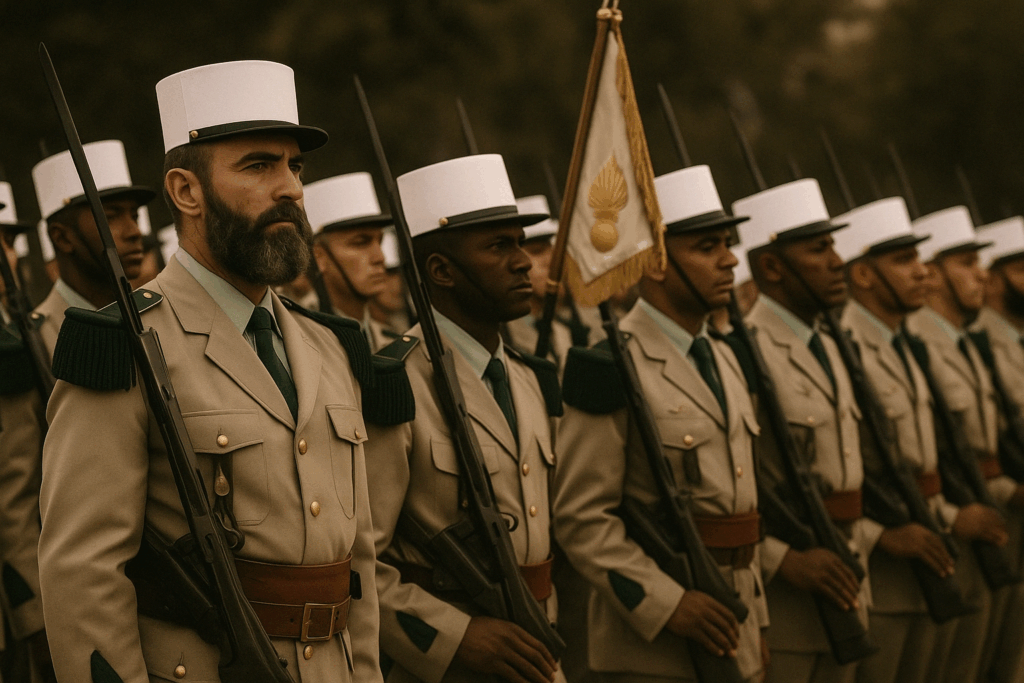
The French Foreign Legion stands as one of the most legendary, mysterious, and revered military forces in the world. Created for exiles and outsiders, it has evolved into a brotherhood bound not by nationality, but by loyalty, honor, and sacrifice. Its motto, “Legio Patria Nostra” — “The Legion is our Fatherland” — embodies the spirit of this elite force, where men from every corner of the globe serve under one flag, ready to fight and die for a nation not originally their own.
The Origins: Birth from Chaos
The French Foreign Legion was founded on March 10, 1831, by King Louis-Philippe. In the wake of political upheaval and military restructuring following the July Revolution, France needed a force that could operate overseas without risking native French troops. The answer was a unit composed of foreign nationals, often exiled or stateless men willing to fight in exchange for a new start.
From its inception, the Legion was a melting pot of misfits, soldiers of fortune, and those seeking redemption — from defeated Polish revolutionaries to Spanish Carlists and German adventurers.
Early Campaigns: Baptism in Blood
The Legion’s early years were marked by brutal colonial wars in Algeria, which soon became its permanent home. These early battles forged the Legion’s fearsome reputation. Its men endured harsh desert conditions, constant combat, and little reward. But they became known for their resilience, fierce loyalty, and combat effectiveness.
Throughout the 19th century, the Legion fought in Mexico, most famously at the Battle of Camarón in 1863, where 65 legionnaires held off 2,000 Mexican troops. Though nearly all perished, their stand became a symbol of Legion honor, and April 30 is now celebrated as Camerone Day, the Legion’s most sacred commemoration.
World Wars: A Force Forged in Fire
During World War I, the Legion played a crucial role in many key battles, particularly at Verdun and the Somme. Thousands of legionnaires gave their lives, many of whom had joined to escape war in their own countries or to fight for the ideals France represented.
In World War II, the Legion again fought bravely, though France’s surrender led to complex loyalties. Some units fought under Free French Forces, while others were forced into Vichy service. Despite the confusion, the Legion remained a symbol of determination and honor, continuing to recruit and fight even as the world fractured around it.
Indochina and Algeria: The Shadows of Colonialism
After WWII, the Legion found itself embroiled in some of France’s most painful conflicts — Indochina and Algeria. The First Indochina War (1946–1954) was especially brutal. Legionnaires faced harsh jungle warfare, guerrilla tactics, and impossible terrain. The fall of Dien Bien Phu marked the end of French colonial rule in Southeast Asia, but the Legion had once again demonstrated unmatched tenacity.
In Algeria, the Legion was deployed against independence fighters during a bitter and controversial war. After Algeria’s independence in 1962, the Legion relocated its headquarters from Sidi Bel Abbès to Aubagne, near Marseille, where it remains today.
Modern Missions: A Global Force
Today, the French Foreign Legion is a key tool of French foreign policy, regularly deployed to hotspots around the globe. Legionnaires have served in Chad, Mali, Central African Republic, Kosovo, Afghanistan, and Iraq. Their duties range from combat to peacekeeping, always with the same unflinching resolve.
Despite its romanticized image, the Legion remains a tough, demanding life. Recruits undergo some of the most rigorous training in the world, learning not just French but how to fight, survive, and operate in diverse terrains and climates.
Who Joins the Legion?
Today, men from over 140 nationalities have served in the Legion. Many seek escape, reinvention, or simply a new challenge. The Legion offers a second chance — and after honorable service, even a path to French citizenship.
But make no mistake: the Legion demands total loyalty. Names are changed. Pasts are buried. The only identity that matters is the green beret and white kepi.
Symbols and Brotherhood
The Legion is deeply rooted in tradition. Its uniforms, parades, slow marching pace, and code of honor set it apart. The Legion hymn, “Le Boudin,” echoes across parade grounds. The wooden hand of Captain Danjou, lost at Camarón, is displayed with reverence, carried each April 30 as a sacred relic.
To be a legionnaire is to belong — not to a country, but to a brotherhood without borders.
Legacy of the Legion
In nearly two centuries, the French Foreign Legion has become more than just a military unit. It is a symbol of rebirth, discipline, and honor through sacrifice. From the sands of Algeria to the mountains of Mali, the Legion has proven that allegiance is not born of birthright but of commitment.
For those willing to walk through fire to find meaning — the Legion stands ready.
Hashtags
#frenchforeignlegion #militaryhistory #legionnaires #foreignlegion #legionpatrianostra #frencharmy #eliteforces #militarytradition #legionofhonor #battleofcamerone #militarylegacy #militaryculture #wartimehistory #historyblog #militarybrotherhood #specialforces #indochinawar #algerianwar #modernmilitary #legionhistory #militaryrecruitment #famousbattles #desertwarfare #soldiersofhonor #globalelement #worldwars #militarylegends #foreignfighters #frenchmilitary #brothersinarms